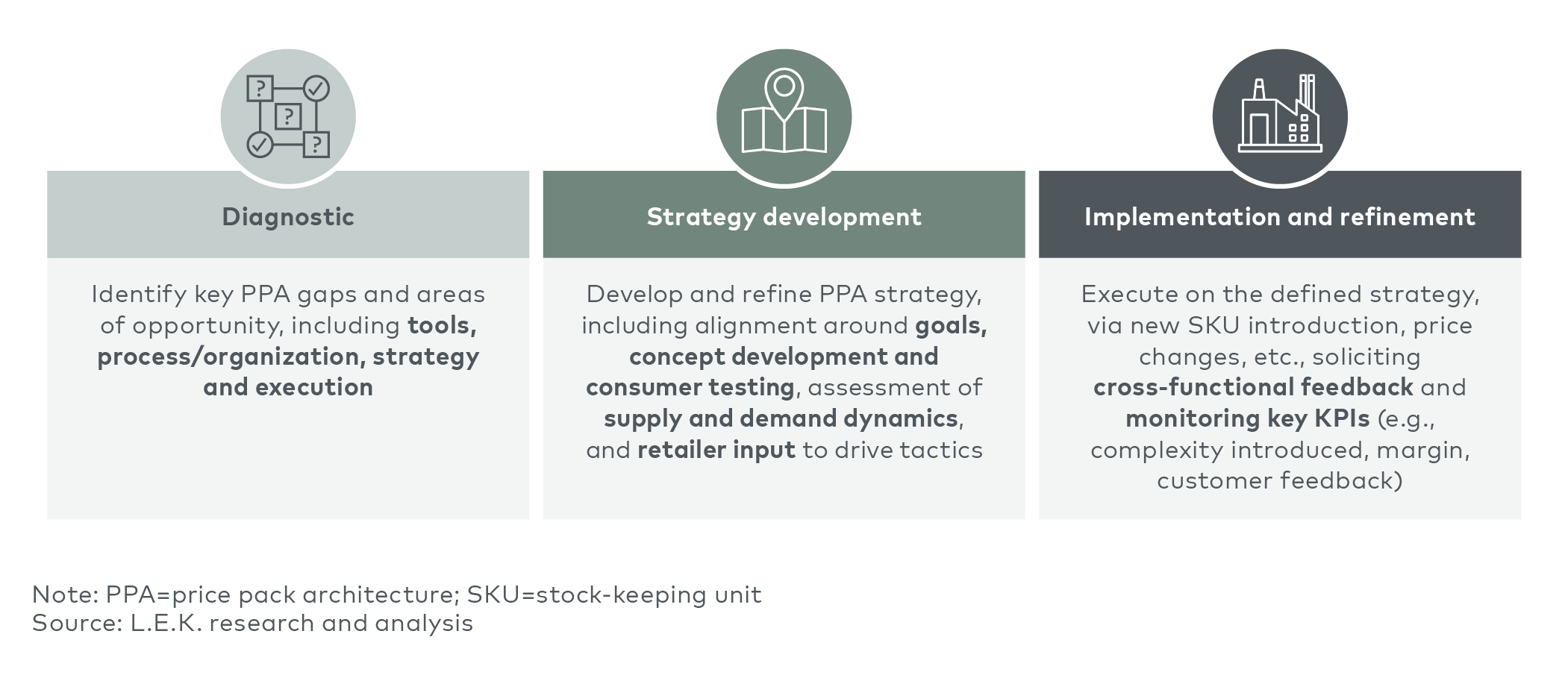Consumer Price Pack Architecture
While many businesses have some degree of formal pricing, trade and mix management processes, price pack architecture (PPA) is often an underdeveloped muscle. PPA is the optimization of product portfolios via analysis of price points, packaging and configurations/attributes to maximize profitability and consumer appeal.
L.E.K. Consulting focuses on a holistic approach to PPA; accretive PPA must focus on creating a “win win win” across:
- The consumer: meeting and exceeding their expectations for value, product attributes and package formats
- The customer: providing each retailer with “something special,” maintaining pricing/feature “rules” as compared to other channels
- The manufacturer: ensuring that products are profitable and drive incremental revenue and don’t add undue complexity to the operations/supply chain, etc.
This approach has three broad components that brand owners and manufacturers should consider when evaluating their PPA strategies:

Diagnostic
Provide a rapid “outside in” diagnostic both internally (tools, organizational structure/governance, strategy, execution and process) and externally (market data, channel partner interviews, competitive benchmarking) to develop a single source of truth “fact base” and identify PPA gaps and vital next steps.
Strategy development
PPA strategy in general has two broad goals:
- Driving organic growth via line extensions and consumer-centric innovation
- Ensuring logical pricing across channels and stock-keeping units (SKUs), limiting channel conflict and aligning with consumer expectations
For both goals, we co-ideate solutions (e.g., new product attributes, pricing changes) with a cross-functional team and then conduct a detailed analysis of
- Consumer behavior and preferences (via direct consumer focus groups, surveys, artificial intelligence analysis of sentiment)
- Market and competitive context (e.g., analog learnings, competitive pricing)
- Current market supply and demand
- Customer and channel partner feedback
Implementation and execution
Formulating the best strategy is only half of the battle, however. The actual implementation and execution of PPA requires significant cross-functional collaboration and organizational harmony.
While each organization is unique, our experience suggests that the effective implantation of PPA strategies requires several key steps:
- End-to-end supply chain consideration to ensure that complexity (new SKUs, pricing regimes) is well managed
- Coordination across functions to “synch up” commercial and operations and ensure that changes are feasible from an operational and customer/market point of view
- Alignment on and measurement of key performance indicators to rapidly assess and course correct strategies
Effective PPA is indeed a muscle, and one that organizations should seek to flex. After successful implementation of a PPA strategy in a single brand, business unit or product line, the process can be optimized and replicated across others, ultimately bringing benefits companywide. PPA strategies can and must evolve as business conditions, consumer trends and goals change; organizations should seek to consistently review and refresh PPA strategies and tactics to ensure their continued relevance.
L.E.K. thought leadership
The New World of Mini Consumer Packaged Goods
Client successes
L.E.K. has deep experience in providing clients with PPA strategies that have helped them both grow top-line revenue and expand margin.
Fortune 100 CPG company: We conducted consumer research to evaluate the importance of package characteristics and ran consumer simulations on various pricing/pack configurations to develop pricing strategies around new product formats (e.g., smaller packs, zippers). The PPA strategy is projected to generate incremental sales of approximately $50 million and about $15 million in EBIT. Read more.
Leading branded CPG food company: Faced with flat sales and a customer flight from frozen to fresh, the company engaged us to conduct consumer research to evaluate claim, flavor, format, package type, package size and protein characteristics. We ran consumer simulations on various PPA configurations to develop a channel-specific product and pricing strategy. The project resulted in a clear product strategy pathway for several marquee brands and significant sales and EBIT increases.
Leading vitamin brand: We evaluated the impact of changing promotion strategy and conducted consumer research to understand the importance of promotions in the purchase process. We ran consumer simulations on various pricing/pack/promotion configurations to develop a pricing strategy and identified potential direct contributions of approximately $20 million through a new pricing and trade promotion strategy.
